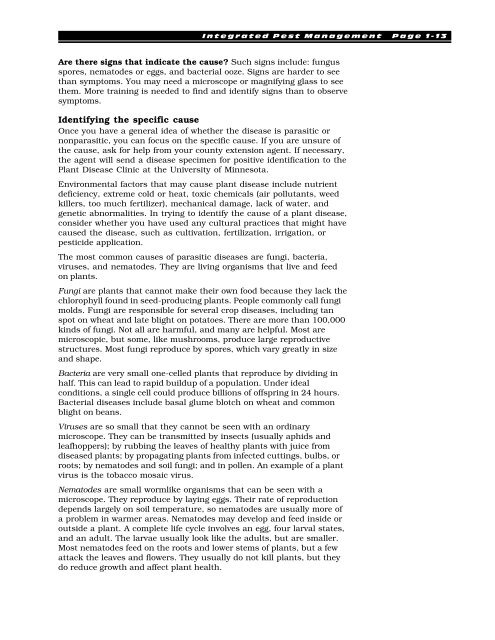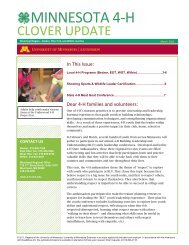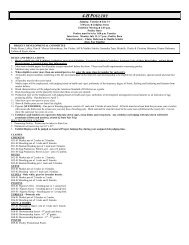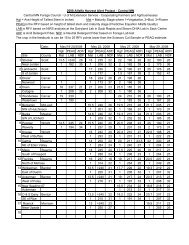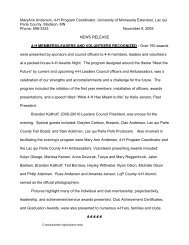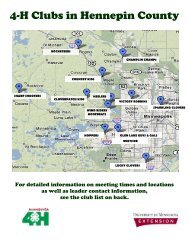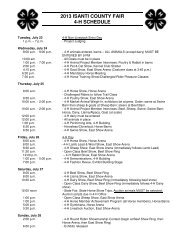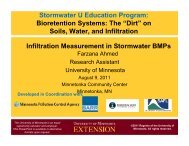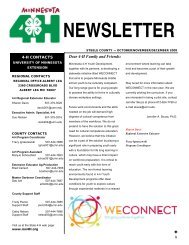Private Pesticide Applicator's Training Manual - University of ...
Private Pesticide Applicator's Training Manual - University of ...
Private Pesticide Applicator's Training Manual - University of ...
You also want an ePaper? Increase the reach of your titles
YUMPU automatically turns print PDFs into web optimized ePapers that Google loves.
Integrated Pest Management Page 1-13<br />
Are there signs that indicate the cause? Such signs include: fungus<br />
spores, nematodes or eggs, and bacterial ooze. Signs are harder to see<br />
than symptoms. You may need a microscope or magnifying glass to see<br />
them. More training is needed to find and identify signs than to observe<br />
symptoms.<br />
Identifying the specific cause<br />
Once you have a general idea <strong>of</strong> whether the disease is parasitic or<br />
nonparasitic, you can focus on the specific cause. If you are unsure <strong>of</strong><br />
the cause, ask for help from your county extension agent. If necessary,<br />
the agent will send a disease specimen for positive identification to the<br />
Plant Disease Clinic at the <strong>University</strong> <strong>of</strong> Minnesota.<br />
Environmental factors that may cause plant disease include nutrient<br />
deficiency, extreme cold or heat, toxic chemicals (air pollutants, weed<br />
killers, too much fertilizer), mechanical damage, lack <strong>of</strong> water, and<br />
genetic abnormalities. In trying to identify the cause <strong>of</strong> a plant disease,<br />
consider whether you have used any cultural practices that might have<br />
caused the disease, such as cultivation, fertilization, irrigation, or<br />
pesticide application.<br />
The most common causes <strong>of</strong> parasitic diseases are fungi, bacteria,<br />
viruses, and nematodes. They are living organisms that live and feed<br />
on plants.<br />
Fungi are plants that cannot make their own food because they lack the<br />
chlorophyll found in seed-producing plants. People commonly call fungi<br />
molds. Fungi are responsible for several crop diseases, including tan<br />
spot on wheat and late blight on potatoes. There are more than 100,000<br />
kinds <strong>of</strong> fungi. Not all are harmful, and many are helpful. Most are<br />
microscopic, but some, like mushrooms, produce large reproductive<br />
structures. Most fungi reproduce by spores, which vary greatly in size<br />
and shape.<br />
Bacteria are very small one-celled plants that reproduce by dividing in<br />
half. This can lead to rapid buildup <strong>of</strong> a population. Under ideal<br />
conditions, a single cell could produce billions <strong>of</strong> <strong>of</strong>fspring in 24 hours.<br />
Bacterial diseases include basal glume blotch on wheat and common<br />
blight on beans.<br />
Viruses are so small that they cannot be seen with an ordinary<br />
microscope. They can be transmitted by insects (usually aphids and<br />
leafhoppers); by rubbing the leaves <strong>of</strong> healthy plants with juice from<br />
diseased plants; by propagating plants from infected cuttings, bulbs, or<br />
roots; by nematodes and soil fungi; and in pollen. An example <strong>of</strong> a plant<br />
virus is the tobacco mosaic virus.<br />
Nematodes are small wormlike organisms that can be seen with a<br />
microscope. They reproduce by laying eggs. Their rate <strong>of</strong> reproduction<br />
depends largely on soil temperature, so nematodes are usually more <strong>of</strong><br />
a problem in warmer areas. Nematodes may develop and feed inside or<br />
outside a plant. A complete life cycle involves an egg, four larval states,<br />
and an adult. The larvae usually look like the adults, but are smaller.<br />
Most nematodes feed on the roots and lower stems <strong>of</strong> plants, but a few<br />
attack the leaves and flowers. They usually do not kill plants, but they<br />
do reduce growth and affect plant health.


